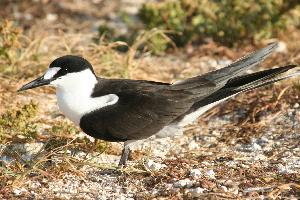
State of endangerment
| Endangered |
Animal description
The Peruvian tern (Sternula lorata) is a captivating and relatively diminutive seabird, belonging to the family Laridae, which encompasses gulls, terns, and skimmers. This species is distinguished by its notably small size, with a delicate structure that embodies grace and agility in flight. The Peruvian tern is endemic to the coastal regions of Peru and the far northern reaches of Chile, making its presence a unique and specialized feature of the Pacific South American coastline.Adult Peruvian terns exhibit a striking plumage that is primarily characterized by a crisp white underbelly contrasted against a pale grey back and wings. The tail is deeply forked, a common trait among terns, aiding in their exceptional aerial maneuverability. One of the most distinctive features of the Peruvian tern is its slender, sharp bill which is predominantly black with a yellow tip, adding a splash of color to its otherwise monochromatic appearance. The bird's head is adorned with a sleek, black cap during the breeding season, which extends from the forehead to just behind the eyes, leaving the face white. Their eyes are encircled by a thin, black line, enhancing their keen, alert expression. Legs and feet are a dark hue, providing a subtle contrast to its lighter body coloration.
Measuring approximately 20 to 25 cm in length and with a wingspan of around 41 to 47 cm, the Peruvian tern is the smallest tern species within its range. Despite its small stature, it is an adept flyer, capable of executing intricate maneuvers in the air as it hunts for fish. Its flight is characterized by a combination of swift, direct flaps and graceful gliding, often hovering momentarily before plunging into the water to catch small fish or invertebrates just below the surface.
The Peruvian tern's habitat is closely tied to sandy or rocky coastlines and adjacent shallow marine waters. These environments provide not only the necessary food resources but also suitable sites for nesting. The species exhibits a strong fidelity to its breeding sites, where it constructs shallow nests directly on the ground, often in areas with sparse vegetation to offer some degree of concealment from predators.
Breeding typically occurs from September to March, a period during which the terns are more conspicuously vocal, engaging in a variety of calls that serve to establish territories, attract mates, and maintain pair bonds. The social structure of the Peruvian tern during this time is quite fascinating, with pairs exhibiting a high degree of cooperation in nest building, incubation of eggs, and rearing of the young.
Conservation status of the Peruvian tern is of considerable concern, as it is classified as Endangered by the International Union for Conservation of Nature (IUCN). Threats to its survival include habitat loss due to coastal development, human disturbance, predation by introduced species, and the impacts of climate change. Conservation efforts are focused on habitat protection, monitoring of populations, and research to better understand the needs and behaviors of this enigmatic seabird.
In summary, the Peruvian tern is a remarkable bird, embodying the grace, agility, and resilience of seabirds. Its specialized existence along the South American Pacific coast underscores the importance of coastal ecosystems not only for the species itself but also for the broader ecological community. Preserving the delicate balance of these habitats is essential for ensuring the continued survival of the Peruvian tern and the myriad of life that shares its environment.
Similar Animals
New photos of animals
Top 10 animals
- Dolphin gull (Leucophaeus scoresbii)
- Diana monkey (Cercopithecus diana)
- Moustached guenon (Cercopithecus cephus)
- Galápagos tortoise (Geochelone nigra complex)
- Japanese macaque (Macaca fuscata)
- Stone loach (Barbatula barbatula)
- Greek tortoise (Testudo graeca)
- Russian tortoise (Testudo horsfieldii)
- Common flying dragon (Draco volans)
- Galápagos penguin (Spheniscus mendiculus)


